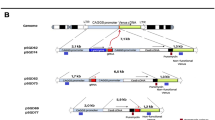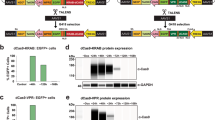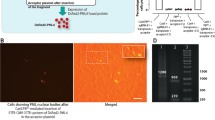Abstract
For the development of human artificial chromosomes (HACs) as a gene transfer vehicle we need to assess the efficiency of de novo chromosome formation depending on the type and the copy number of transferred DNA constructs. In order to check transient EGFP expression as a reporter to immediately detect presence of transfected DNA, we microinjected approximately 1 to 105 copies of pEGFP-N1 plasmid into the nucleus of various cell types. Whether using primary, immortalized, or tumor cells, at least 103–104 copies were required to generate a visible green signal in the majority of the 50–90% of cells surviving injection. Generally, the cells showed relatively constant, copy number-dependent signals. 103 copies resulted in faint and 105 in bright fluorescence under the microscope. In addition, the different copy number groups contained a small fraction of cells showing much stronger fluorescence, indicating activation or lack of suppression which facilitates detection of as few as 102 transferred copies in rare instances. Thus, transient expression from single copies is not sufficient to reliably detect presence of DNA in the nucleus. The result is relevant for the development of low copy HAC transfer protocols.
This is a preview of subscription content, access via your institution
Access options
Subscribe to this journal
Receive 12 print issues and online access
$259.00 per year
only $21.58 per issue
Buy this article
- Purchase on Springer Link
- Instant access to full article PDF
Prices may be subject to local taxes which are calculated during checkout

Similar content being viewed by others
References
Harrington JJ et al. Formation of de novo centromeres and construction of first-generation human artificial microchromosomes Nat Genet 1997 15: 345–355
Ikeno M et al. Construction of YAC-based mammalian artificial chromosomes Nat Biotechnol 1998 16: 431–439
Henning KA et al. Human artificial chromosomes generated by modification of a yeast artificial chromosome containing both human alpha satellite and single-copy DNA sequences Proc Natl Acad Sci USA 1999 96: 592–597
Ebersole TA et al. Mammalian artificial chromosome formation from circular alphoid input DNA does not require telomere repeats Hum Mol Genet 2000 9: 1623–1631
Mejia JE et al. Functional complementation of a genetic deficiency with human artificial chromosomes Am J Hum Genet 2001 69: 315–326
Grimes BR et al. Stable gene expression from a mammalian artificial chromosome EMBO Rep 2001 2: 910–914
Schindelhauer D . Construction of mammalian artificial chromosomes: prospects for defining an optimal centromere Bioessays 1999 21: 76–83
Willard HF . Genomics and gene therapy. Artificial chromosomes coming to life Science 2000 290: 1308–1309
Inouye S, Tsuji FI . Aequorea green fluorescent protein. Expression of the gene and fluorescence characteristics of the recombinant protein FEBS Lett 1994 341: 277–280
Zhang G, Gurtu V, Kain ST . An enhanced green fluorescence protein allows sensitive detection of gene transfer in mammalian cells Biochem Biophys Res Com 1996 227: 707–711
Kar-Roy A et al. Green fluorescence protein as a transcriptional reporter for the long ternimal repeat of the human immunodeficiency virus type 1 J Virol Meth 2000 84: 127–138
Minaschek G, Bereiter-Hahn J, Berthold G . Quantitation of the volume of liquid injected into cells by means of pressure Exp Cell Res 1989 183: 434–442
Pollard H et al. Polyethylenimine but not cationic lipids promotes transgene delivery to the nucleus in mammalian cells J Biol Chem 1998 273: 7507–7511
Gruenert DC et al. Characterization of human tracheal epithelial cells transformed by an origin-defective simian virus 40 Proc Natl Acad Sci USA 1988 85: 5951–5955
Lalande M . A reversible arrest point in the late G1 phase of the mammalian cell cycle Exp Cell Res 1990 186: 332–339
Chida K, Sueyoshi R, Kuroki T . Efficient and stable gene transfer following microinjection into nuclei of synchonized animal cells progressing from G1/S boundary to early S phase Biochem Biophys Res Commun 1998 249: 849–852
Siedow A, Gratchev A, Hanski C . Correct evaluation of reporter assays in different cell lines by direct determination of the introduced plasmid amount Eur J Cell Biol 2000 79: 150–153
Acknowledgements
We thank Jim Lausier and Josef Rosenecker for help with immunostaining and access to imaging equippment, Dieter Gruenert and the University of Califonia for providing a batch of 16HBE14o−, Brenda Grimes for HT1080 cells, Konstanze Hörtnagel for sparing batches of human fibroblasts, and Thomas Meitinger for his support. The work was supported by grants to DS from the Deutsche Forschungsgemeinschaft (DFG), the Friedrich Baur Stiftung, and the Forschungsgemeinschaft Mukoviszidose.
Author information
Authors and Affiliations
Rights and permissions
About this article
Cite this article
Schindelhauer, D., Laner, A. Visible transient expression of EGFP requires intranuclear injection of large copy numbers. Gene Ther 9, 727–730 (2002). https://doi.org/10.1038/sj.gt.3301755
Published:
Issue Date:
DOI: https://doi.org/10.1038/sj.gt.3301755
Keywords
This article is cited by
-
Integrated Electrowetting Nanoinjector for Single Cell Transfection
Scientific Reports (2016)



